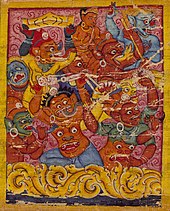Type a search term to find related articles by LIMS subject matter experts gathered from the most trusted and dynamic collaboration tools in the laboratory informatics industry.
| Translations of Māra | |
|---|---|
| English | Mara; Demon |
| Sanskrit | मार, Māra |
| Pali | Māra |
| Burmese | မာရ်နတ် (MLCTS: Marnat) |
| Chinese | 天魔; 魔羅; 魔罗 (Pinyin: Tiān Mó; Mó Luó; Mó Luó) |
| Indonesian | Mara; Setan; Iblis |
| Japanese | 魔羅; マーラ; 天魔 (Rōmaji: Mara; Māra; Tenma) |
| Khmer | មារ (UNGEGN: Méru) |
| Korean | 마라 (RR: Mara) |
| Sinhala | මාරයා (Mārayā) |
| Tibetan | བདུད (Wylie: bdud) |
| Thai | มาร (RTGS: Māra) |
| Vietnamese | Thiên Ma |
| Glossary of Buddhism | |




Mara,[note 1] in Buddhism, is an Asura malignant celestial king who tried to stop Prince Siddhartha from achieving Enlightenment by trying to seduce him with his celestial Army and the vision of beautiful women who, in various legends, are often said to be Mara's daughters.[1]
In Buddhist cosmology, Mara is associated with death, rebirth and desire.[2] Nyanaponika Thera has described Mara as "the personification of the forces antagonistic to enlightenment."[3]
He is Yama's fearsome persona and all beings associated with him, darkness and death, become forces of Mara. These forces consist of Yaksas, Raksases, Pisacas, Aratis and animals.[4]
His name is first mentioned in the Atharva Veda (1200 BCE–1000 BCE) as Yama, Mrtyu and Agha Mara, the evil slayer. He is called the "evil one who kills" and "Papiyan", denoting a being which is not only morally bad but intertwined with sorrow, pain and misfortune.[5]
While Mara's origin is of Hindu nature, the development of the symbolism of Mara was spread by Buddhism.[6]
The word Māra comes from the Sanskrit form of the verbal root mṛ. It takes a present indicative form mṛyate and a causative form mārayati (with strengthening of the root vowel from ṛ to ār). Māra is a verbal noun from the causative root and means 'causing death' or 'killing'.[7] It is related to other words for death from the same root, such as: maraṇa and mṛtyu. The latter is a name for death personified and is sometimes identified with Yama.
The root mṛ is related to the Indo-European verbal root *mer meaning "die, disappear" in the context of "death, murder or destruction". It is "very wide-spread" in Indo-European languages suggesting it to be of great antiquity, according to Mallory and Adams.[8]
In traditional Buddhism, four or five[citation needed] metaphorical forms of Māra are given:[9]
Early Buddhism acknowledged both a literal and psychological interpretation of Mara.[10][11]
Mara is described both as an entity having an existence in Kāma-world,[12] just as are shown existing around the Buddha, and also is described in pratītyasamutpāda as, primarily, the guardian of passion and the catalyst for lust, hesitation and fear that obstructs meditation among Buddhists. The Denkōroku refers to him as the "One Who Delights in Destruction", which highlights his nature as a deity among the Parinirmitavaśavarti devas.[13]
"Buddha defying Mara" is a common pose of Buddha sculptures.[14][15] The Buddha is shown with his left hand in his lap, palm facing upwards and his right hand on his right knee. The fingers of his right hand touch the earth, to call the earth as his witness for defying Mara and achieving enlightenment. This posture is also referred to as the bhūmisparśa "earth-witness" mudra.
In some accounts of the Buddha's enlightenment, it is said that the demon Māra did not send his three daughters to tempt but instead they came willingly after Māra's setback in his endeavor to eliminate the Buddha's quest for enlightenment.[16] Mara's three daughters are identified as Taṇhā (Thirst), Arati (Aversion, Discontentment), and Rāga (Attachment, Desire, Greed, Passion).[15][17] For example, in the Samyutta Nikaya's Māra-saṃyutta, Mara's three daughters were undressing in front of the Buddha; but failed to entice him:
The three daughters of Māra were inspired by Aratis, a type of feminine goblin that was associated with avarice.[19]
The Jingde Record of the Transmission of the Lamp and the Denkoroku both contain a story of Mara's conversion to Buddhism under the auspices of the monk Upagupta.
According to the story, Upagupta journeyed to the kingdom of Mathura and preached the Dharma with great success. This caused Mara's palace to tremble, prompting the deity to use his destructive powers against the Dharma. When Upagupta entered samadhi, Mara approached him and slipped a jade necklace around his neck.
Upagupta reciprocated by transforming the corpses of a man, a dog, and a snake into a garland and gifted it to Mara. When Mara discovered the true nature of the gift, he sought the help of Brahma to remove it. Brahma informed him that because the necklace was bestowed by an advanced disciple of the Buddha, its effects could only be assuaged by taking refuge in Upagupta.
Mara returned to the human world where he prostrated before the monk and repented. At Upagupta's recommendation, he vowed never to do harm to the Dharma and took refuge in the Three Jewels.[20]
Mara appears in Roger Zelazny's 1967 novel Lord of Light as a god of illusion.[21]
Mara has appeared as a recurring Demon in the Megami Tensei franchise, as well as in its spinoffs. Here, Mara takes the appearance of a giant penis riding a golden chariot. Mara has consistently been one of the most popular demons in the series, even reaching #1 popularity on some demon popularity polls.[22]
In 2020, the singer-songwriter Jack Garratt released a song entitled "Mara". Inspired by the story of Mara's distraction of the Buddha, "Mara" describes Garratt's experience of intrusive thoughts.[23]